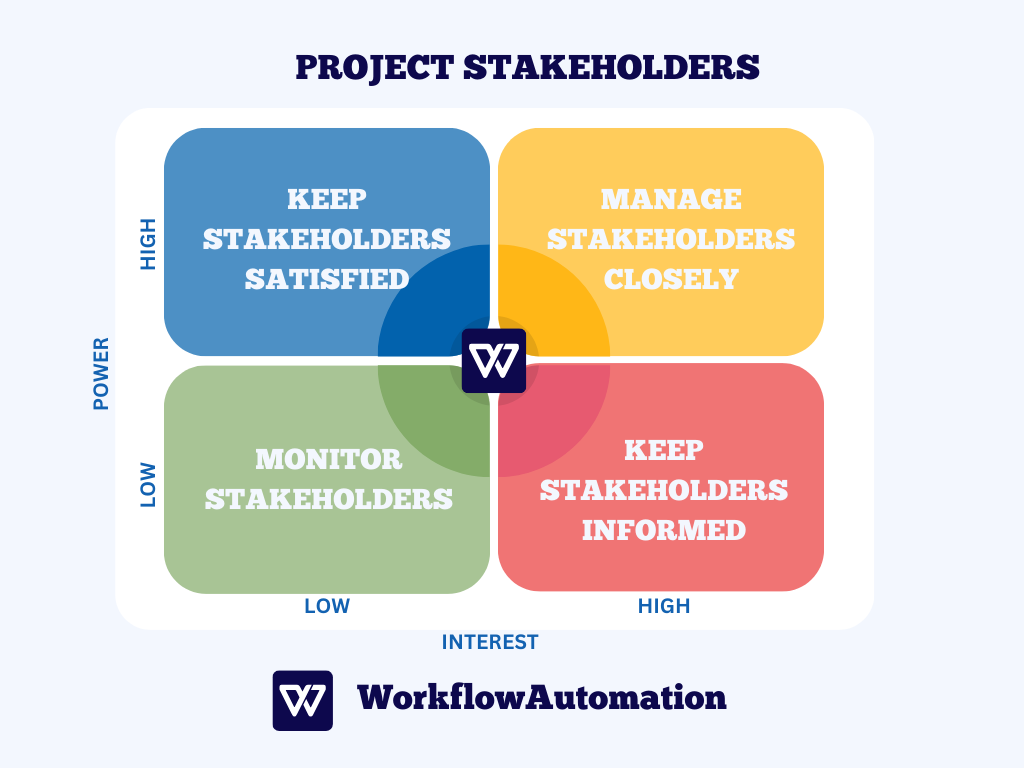Understanding the critical dynamics of project stakeholders is fundamental to achieving project success.
Simply put, a project can only be implemented with effective collaboration among the team, project managers, and project owners, as well as external factors such as sponsors, consultants, and others.
However, it is necessary to understand who the project stakeholders are and the relationship between their actions and the project outcome. That is why we got together with a few experts on our team to do a deeper dive on the role of project stakeholders and break it down for you.
Let’s get started!
What is a Stakeholder?
Project stakeholders are individuals, groups, or organizations directly or indirectly involved in the project whose outcome will positively or negatively affect them.
Some examples of project stakeholders are project team members, owners, resource managers, and customers. Besides customers, these individuals are actively involved in the project, working towards its implementation and aiming for a specific result.
Additionally, some organizations can act as project stakeholders, such as when a company provides funding to a start-up project to acquire in the future.
Project stakeholders are always vested in the project outcome, making them participants. That fact implies an obligation for the project team to give them sufficient attention and listen to their ideas.
Types of Project Stakeholders
When the concept of project stakeholders is interpreted extensively, the list of individuals and organizations considered stakeholders can be pretty long.
However, there is a distinction among all potential project stakeholders, primarily in their active involvement, invested resources, and interest in the project outcome.
Project management has established a division between internal and external stakeholders.
Let’s see what is characteristic of each of these groups.
Internal Stakeholders
At the forefront, internal project stakeholders are those actively involved in the project and for whom the project outcomes are practically the primary goal.
They include employees, project managers, resource managers, executives, and project sponsors.
Including these stakeholders in the list implies that they are all part of a cohesive entity, such as a company, and play critical roles in all project stages, from its inception to completion.
External Stakeholders
External project stakeholders may directly impact the project to a different extent than internal stakeholders. However, they continue to experience various effects of the project’s outcome, sometimes even without being fully aware.
Rather than list all external project stakeholders, which could be time-consuming, let’s mention some examples to help you differentiate between these two types.
The most representative sample is the government and other governmental bodies. They establish regulations that govern the operational framework of practically all industries (construction, manufacturing, etc.). By enacting laws, standards, and health procedures, they influence the project, as companies must comply with them.
Therefore, all parties not directly involved in the project but who impact the project’s outcome are considered external project stakeholders.
Importance of Project Stakeholders
Stakeholders are indispensable to the initiation and execution of projects due to their pivotal role in ensuring successful outcomes. The significance of stakeholders is closely tied to their connection with the project, be it through their decision-making authority or their contributions of experience, knowledge, and expertise.
In this section, we will delve into three crucial roles that project stakeholders play.
#1. Project Stakeholders Are Knowledgeable
Project stakeholders, selected based on their expertise in the project’s domain, are essential for the project’s quality and value.
Their profound understanding of the subject matter ensures that decisions made throughout the process are well-informed, based on reliable information, and lead to effective solutions.
By relying on stakeholders’ expertise, projects can avoid unnecessary detours, minimize time waste, and achieve a high level of quality.
#2. Project Stakeholders Can Identify Risks
When managing a project, it is essential to involve someone with previous experience in project management, particularly with similar or related goals.
These experienced individuals or organizations provide valuable insights into what to expect along the project journey and the potential problems that may arise. It is crucial to be aware of potential challenges in advance, allowing you to react promptly when issues occur.
By involving stakeholders in the project’s overall concept and activities, you can identify, analyze, and tackle potential problems more effectively, enabling timely and efficient project implementation.
#3. Project Stakeholders Keep the Project on Track
By identifying all individuals and organizations connected to the project and actively involving them in the process, project teams establish open channels of communication. This enables the team to stay informed about the project’s progress, identify opportunities for improvement, and address necessary changes.
Through ongoing engagement with stakeholders and their valuable feedback, projects can maintain a steady trajectory, ensuring a seamless flow and a positive outcome.
Additionally, effective stakeholder communication, support, and collaboration enable project teams to navigate and mitigate any negative outcomes encountered during the project’s implementation.
How to Conduct a Project Stakeholders Analysis
Effective stakeholder management is crucial for project success. Thoroughly researching and involving stakeholders can bring many benefits, while neglecting them can lead to risks and jeopardize the project’s outcome.
Therefore, approach project stakeholder analysis with caution, keeping the following points in mind:
#1. Identify Project Stakeholders
The first step in conducting a project stakeholder analysis is to identify all potential individuals or organizations that may have an impact on the project, benefit from it, or pose certain challenges.
To create a comprehensive list of stakeholders, you can use various methods, such as brainstorming, to generate ideas and identify anyone who may be involved in or affected by the project.
You can also review documents to establish project-related documentation, such as project plans and stakeholder registers, which are used to identify key individuals or groups associated with the project. This can provide valuable insights into project stakeholders’ roles and responsibilities.
Or use some programs to help you create a list of potential stakeholders based on their impact and interest.
#2. Understand Project Stakeholders
When you identify potential stakeholders, gather as much information as possible from them regarding the project’s implementation.
Why is this important?
It is important because your perspective on the project can be subjective and could lead to overlooking key aspects that stakeholders, due to their influence, interest, or expertise, can help identify and address in a timely manner.
Therefore, making approaches like conducting interviews or studying the backgrounds of project stakeholders will help you gain insights into their viewpoints, expectations, and understanding of your project’s objectives and implementation approach.
#3. Prioritize Project Stakeholders
The role of stakeholders in project implementation is significant, but not all stakeholders hold the same level of importance for the project. It is crucial to devote attention to stakeholders based on their significance to your project and create a project stakeholder matrix to help with this prioritization.
Prioritizing stakeholders should be done based on their impact on your project and their level of interest. By categorizing stakeholders, you will know how much focus and effort to allocate to each group.
There are four possible outcomes to consider:
Powerful stakeholders with a high level of interest: Maintain a strong relationship with these stakeholders because you can benefit from them the most. Try to align with their goals and requests as much as possible, keep them informed, and ensure they are content.
Powerful stakeholders with low interest: With this group of stakeholders, be sure to make yourself available to them and devote attention to their needs, but avoid overwhelming them with excessive information.
Less powerful stakeholders with high interest: This group of stakeholders may not have significant influence, but they can still be valuable, as they often possess relevant information related to the project. For example, individuals who live in the area and know about its ecosystem may be able to explain how the project might affect the environment.
Less powerful stakeholders with low interest: Keep them informed about project updates, but do not invest excessive resources in engaging them; it is enough to ensure they are in the loop on project developments.
How to Manage Project Stakeholders
Managing multiple stakeholders, particularly internal ones, can be challenging as their desires, requests, and interests may vary within the project scope.
The project acts as a unifying force, bringing all participants together in one place with a shared purpose. Consequently, it becomes crucial to prioritize the project’s interests and the collective well-being over the individual interests of each stakeholder.
To ensure the cohesion of the project, we have created a series of steps that encourage active participation from everyone involved.
#1. Define Each Stakeholder’s Role
Each project stakeholder must have a clearly defined role in the system and execution process. When everyone knows what they need to do and what their authorities are, the possibility of mutual interference, exceeding charges, and confusion is reduced.
Let’s take the example of a resource manager and a product testing department manager.
The task of the resource manager is to provide resources to the department based on the established budget. Of course, it is assumed that communication between them occurs regularly.
However, this does not mean that the resource manager can dictate the product testing methodology the department will implement, nor should the department members interfere in the resource manager’s work.
By strictly dividing tasks and roles within the organization and respecting them, collaboration and team efficiency increase, leading to better results.
#2. Involve Stakeholders in the Project
Once you have identified all project stakeholders and assigned roles within the organization, involving them throughout the project lifecycle is crucial. That gives them a sense of belonging to the team and motivates them to persevere until the project’s completion.
How can this be done?
Maintain ongoing communication channels with stakeholders throughout the project timeline. This means providing stakeholders with regular updates on project progress and milestones.
Additionally, seek their feedback, address their concerns, and involve them in decision-making.
Encourage stakeholders to participate in decision-making by gathering their insights, perspectives, and expertise to make informed choices.
It is important to involve stakeholders in project closure activities, such as final reviews, lessons-learned sessions, and celebrations of achievements.
#3. Keep Track of Communication
Effective stakeholder management begins with active listening. Project managers must attentively engage with stakeholders to comprehend their perspectives, concerns, and aspirations.
Project managers create a reliable record of critical decisions, feedback, and action items by documenting these conversations through meeting minutes or digital collaboration tools like Jira, for example. That makes stakeholders feel valued, as their input is acknowledged and incorporated into the project’s trajectory.
Documenting communication with stakeholders not only fosters transparency but also creates a culture of openness and accountability. By sharing communication records, project managers demonstrate their commitment to collaboration and develop a shared understanding of project objectives.
#4. Establish Processes
Change is inevitable in any project; managing it is crucial to success. Project managers must establish a change management framework that outlines the processes and protocols for evaluating and implementing changes.
By engaging stakeholders in this evaluation process, project managers can effectively communicate the potential risks and trade-offs associated with change requests. With clear procedures for change requests, stakeholders have a structured channel to communicate their desired modifications.
That promotes a collaborative atmosphere while ensuring that changes are assessed, prioritized, and implemented in alignment with project goals.
Conclusion
Therefore, stakeholders are integral to every project and essential for its purpose. The project outcome impacts project stakeholders, whether internal or external, and this adds value to the project.
We have seen the significance of collaboration, understanding, and proper distribution of roles among stakeholders for project success.
The project management team is responsible for reconciling the interests, desires, and visions of all relevant stakeholders, ensuring that the project will undoubtedly have a successful outcome.







